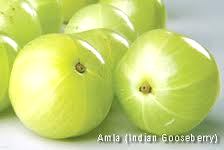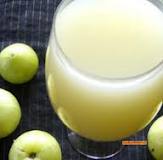Indian Gooseberry or Embelica Officinelis has derived its name from Sanskrit name, ‘ Amalika’ meaning (sour juice of the fruit) i.e.Embelica and officinalis means – Of service to man. Its synonyms are Dhatri, Amruta, Vayastha. Commonly known as Amla in hindi, Amla is a greenish yellow colored fruit having six longitudinal lines and a hexagonal seed inside. This fruit is available between October to February . It is a rich source of vitamin C and many other nutritional and medicinal properties. It is useful in a simple anorexia, nausea like symptom to diabetes, urinary complaints and rasayan (increasing longevity) purposes. Only ripe fruit is used for medicinal purposes.
Sanskrit name, ‘ Amalika’ meaning (sour juice of the fruit) i.e.Embelica and officinalis means – Of service to man. Its synonyms are Dhatri, Amruta, Vayastha. Commonly known as Amla in hindi, Amla is a greenish yellow colored fruit having six longitudinal lines and a hexagonal seed inside. This fruit is available between October to February . It is a rich source of vitamin C and many other nutritional and medicinal properties. It is useful in a simple anorexia, nausea like symptom to diabetes, urinary complaints and rasayan (increasing longevity) purposes. Only ripe fruit is used for medicinal purposes.
Family : Amalaki belongs to Euphorbiaceae family.
Rasa : Amla is predominantly sour in taste, the secondary rasas (anurasa) are madhur (sweet), kashay (astringent), katu (pungent) and tikta(bitter) ; but inspite of its sour taste its post-digestive effect (vipaka) is madhur and its potency (virya) is shita (cold).
Amalaki is tridoshaghna by nature, its sour taste pacifies Vata, madhur rasa, madhur vipaka and shita virya helps to pacify Pitta dosha, and its kashay rasa and ruksha guna decreases Kapha; so it is used in any dosha related symptoms.
It increases digestive fire (dipan) and accelerates digestion, thus regulate the metabolism. Amla juice reduces pitta & associated diseases like burning sensations, nausea, vomiting, headache, acidity etc. It refreshes and rejuvenates the body and also decreases excessive thirst and giddiness. Amla preparation like ‘moramla’ reduce pitta and also in mala – anuloman(smooth passing of faeces), mutrakruchra(urinary disorders).
diseases like burning sensations, nausea, vomiting, headache, acidity etc. It refreshes and rejuvenates the body and also decreases excessive thirst and giddiness. Amla preparation like ‘moramla’ reduce pitta and also in mala – anuloman(smooth passing of faeces), mutrakruchra(urinary disorders).
Amalaki is choice of drug in diabetes “meheshu dhatri nisha”. It decrease the kleda content (one of the causative factor of diabetes) in body and urine. Amala churna along with turmeric powder when used in diabetes helps to reduce blood sugar level.
Amala strengthen the indriyas and its functions, it acts as a good nervine tonic and brain tonic.
Amla extract is instilled in eyes for certain eye related diseases. Amla / Triphala ghrit is used for ‘netra tarpan’ in dry eye condition, it as well enhances vision.
Amla / triphala decoction is used for eye wash to prevent eye diseases. Amla paste when applied wit seasame and milk cures Kushtha (skin diseases).
Application of amla with milk reduces headache.
Massage with oil medicated with amla prolongs ageing and decreases hair fall and premature graying of hair. It serves as good hair tonic, and a good rejuvenating agent for skin.
Amla decoction cleanses and also heals the wound
Amla churna when taken with ghee and sugar early in the morning acts as rasayan and prevents premature graying of hair, vimal indriya(cleanses indriya) and increases dhatu qualitatively and quantitatively.
Amla due to its madhur anurasa, and its post digestive effect also being madhur acts as aphrodisiac and also increases sperm count. Amla is a good uterine tonic.
Chardi (vomitting): In vomiting with associated symptoms of pitta Amla churna is given along with chandan (sandal)churna.
In chronic conditions of fever (jirna jwara), decoction of Amlaki pacifies rasagat dosha and also purifies it thus rebuilding the body tissues. Thereafter amla ghrutha is use to prevent its recurrence.
To prevent recurrence of cough, asthma and dhatukashy, amla is used as rasayana in form of chyawanaprasha, amrutprasha, amla ghrit,etc.
Amla if eaten daily improves refreshes and cleanses mouth, prevents bad breathe,increases taste and hunger, builds skin tone,cures bleeding gums and most importantly prolongs ageing. It has so many benefits because of which it is also known as poor man’s apple; so now we can as well say “An Amla a day keeps ageing away”